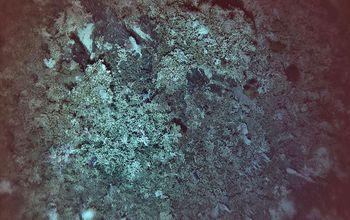Researchers make improbable discovery

Scientists ask how it's possible that certain coral reefs are thriving in this location. Credit: Amy Baco-Taylor
Scientists had long believed that the waters of the Central and Northeast Pacific Ocean were inhospitable to certain species of deep-sea corals, but a marine biologist's discovery of an odd chain of reefs suggests there are mysteries about the development and durability of coral colonies yet to be uncovered.
Scientist Amy Baco-Taylor of Florida State University (FSU), in collaboration with researchers from Texas A&M University, found the reefs during an autonomous underwater vehicle survey of the seamounts of the Northwestern Hawaiian Islands.
In a paper published today in the journal Scientific Reports, Baco-Taylor and her team document the reefs. They also discuss possible explanations for the reefs' appearance in areas considered hostile to large communities of scleractinia — small, stony corals that settle on the seabed and grow bony skeletons to protect their soft bodies.
“I've been exploring the deep sea around the Hawaiian Archipelago since 1998, and have seen enough to know that the presence of the reefs at these depths was definitely unexpected,” Baco-Taylor said.
Some ocean areas, such as the North Atlantic and South Pacific, are particularly fertile habitats for deep-sea scleractinian reefs, but a combination of factors led scientists to believe that finding these coral colonies was exceedingly unlikely in the deep waters of the North Pacific.
The North Pacific's low level of aragonite, an essential mineral in the formation of scleractinian skeletal structures, makes it difficult for the coral polyps to develop their rugged skeletons.
In addition, North Pacific carbonate dissolution rates, a measure of the pace at which carbonate substances such as coral skeletons dissolve, exceed those of the more amenable North Atlantic by a factor of two.
In other words, said Baco-Taylor, the reefs simply should not exist in the North Pacific.
“Even if the corals could overcome low aragonite saturation and build up robust skeletons, there are areas on the reefs that are just exposed skeleton, and those should be dissolving,” Baco-Taylor said. “We shouldn't be finding an accumulation of reefs.”
The researchers suggest potential reasons for the improbable success of these hardy reefs. Among them, higher concentrations of chlorophyll in the areas of reef growth suggest that an abundance of food may provide the excess energy needed for calcification in waters with low aragonite saturation.
But that doesn't tell the whole story.
It doesn't explain “the unusual depths of the reefs, or why, moving to the northwest along the seamounts, they get shallower,” Baco-Taylor said. “There's still a mystery as to why these reefs are here.”
The unexpected discovery of the reefs has prompted some scientists to reconsider the effects of ocean acidification on vulnerable coral colonies. At a time when stories about the wholesale demise of reefs around the world are sparking alarm, these findings may offer a glimmer of hope.
“These results show that the effects of ocean acidification on deep-water corals may not be as severe as predicted,” said David Garrison, a program director in the National Science Foundation's Division of Ocean Sciences, which funded the research. “What accounts for the resilience of these corals on seamounts in the Pacific, however, remains to be determined.”
The reefs occur primarily outside the protected Papahanamoukuakea Marine National Monument, which means they exist in areas where destructive trawling is permitted and active.
Researcher Nicole Morgan of FSU, also a co-author of the paper, said that locating the survivalist reefs is crucial because it gives scientists a chance to preserve them.
“We want to know where these habitats are so that we can protect them,” Morgan said. “We don't want important fisheries to collapse, which often happens when reefs disappear.”
The discovery of the puzzling reefs shows that there are still gaps in scientists' understanding of the deep sea. The success of hypothesis-driven exploration, like the kind that produced these findings, demonstrates the importance of continuing to strike out into the unknown, said Baco-Taylor.
“These results highlight the importance of doing research in unexplored areas, or 'exploration science,' as we like to call it,” said Brendan Roark of Texas A&M University, project co-principal investigator with Baco-Taylor.
If there are additional similar reefs sprinkled across the Northwestern Hawaiian seamounts, Baco-Taylor wants to find them. Further study of these reefs could reveal important information about how they might endure in a time of climbing carbon dioxide levels and increasing ocean acidification.
“If more of these reefs are there, that would run counter to what ocean acidification and carbonate chemistry dictate,” Baco-Taylor said.
“It leaves us with some big questions: Is there something we're not understanding? How is the existence of these reefs possible?”
Media Contact
All latest news from the category: Earth Sciences
Earth Sciences (also referred to as Geosciences), which deals with basic issues surrounding our planet, plays a vital role in the area of energy and raw materials supply.
Earth Sciences comprises subjects such as geology, geography, geological informatics, paleontology, mineralogy, petrography, crystallography, geophysics, geodesy, glaciology, cartography, photogrammetry, meteorology and seismology, early-warning systems, earthquake research and polar research.
Newest articles

Pinpointing hydrogen isotopes in titanium hydride nanofilms
Although it is the smallest and lightest atom, hydrogen can have a big impact by infiltrating other materials and affecting their properties, such as superconductivity and metal-insulator-transitions. Now, researchers from…

A new way of entangling light and sound
For a wide variety of emerging quantum technologies, such as secure quantum communications and quantum computing, quantum entanglement is a prerequisite. Scientists at the Max-Planck-Institute for the Science of Light…

Telescope for NASA’s Roman Mission complete, delivered to Goddard
NASA’s Nancy Grace Roman Space Telescope is one giant step closer to unlocking the mysteries of the universe. The mission has now received its final major delivery: the Optical Telescope…



